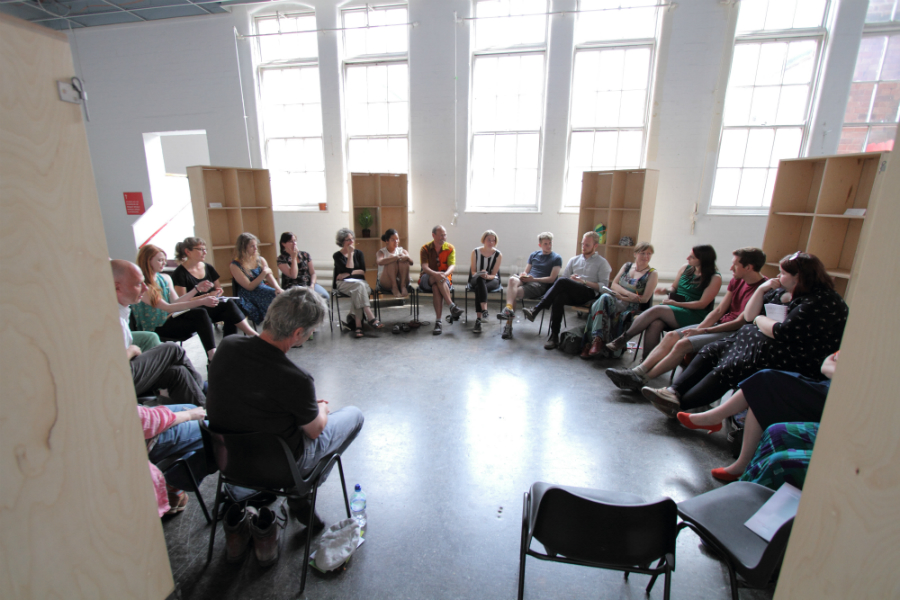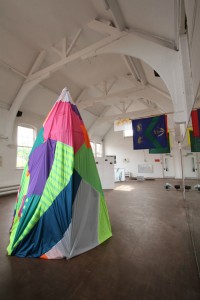Introducing: Primary, Nottingham

Wayne Burrows takes us on a whirlwind tour of Nottingham’s latest contemporary arts space, exposing a history of impressive, close-knit collaborations..
Nottingham has a strange attitude to itself, a point made most recently in Adrian Jones and Chris Matthews’ book Towns In Britain (Five Leaves), an Ian Nairn-style stroll through 20-odd UK towns and cities. Their chapter on Nottingham paints a vivid picture of their home town as a place that has grand ambitions but still thinks like a much smaller place; a city that is simultaneously radical and conservative; that remains something of a ‘reluctant city’; a city whose eccentric boundaries and division into six boroughs split between frequently antagonistic City and County councils mean only around half of the large urban conurbation’s population technically live there.
These unique circumstances impact on the city’s art scene in all kinds of ways. The tightly bounded urban centre puts different activities into close proximity, with studio groups and large institutions, universities and practitioners in other art forms, like dance, literature and performance, all obliged to share space, overlap, and not infrequently combine in ways less often found in more expansive places.
This widespread collaboration energises the work made here, but can also constrain it. The local geography, if you like, encourages a certain insouciance about promoting the artists emerging from it on a national stage, which may be why individual artists and collectives based in Nottingham are seen everywhere and are often influential, but few emphasise their Nottingham connections.
The city’s artist-led sector has expanded rapidly in the last decade, partly in anticipation and response to the opening of New Art Exchange in late 2008 and Nottingham Contemporary the following year. Primary, set up in an old school building just outside the city centre, is — on paper at least — one of the most recent arrivals on that scene, opening its doors to its first intake of artists in late 2011 and reaching capacity during spring 2012. Since then, the grade II listed former primary school building, a labyrinth of corridors and classrooms centred on two large project spaces, has been home to a group of resident artists that range from collectives like Hatch, Active Ingredient and Reactor to the sculptor Kashif Nadim Chaudry, the painter Yelena Popova, the design company Joff + Ollie, and the sound artist Rebecca Lee.
Initially, activity focused on building relationships among the disparate artists within the building, with low-key, in-house presentations and discussions evolving into a 15-month series of public collaborations between resident artists under the heading of Old Skool Breaks. These randomly paired artists, literally drawing names from video-artist Frank Abbott’s hat, and assigned each pairing a month during which new collaborative work would be developed and presented. The results ranged from Mik Godley and Rebecca Beinart’s joint exploration of origins and war-time family history, to Simon Withers and Deborah Swann’s playful merging of sculptural and process-based practices in a one-night exhibition of videos and objects, and plans are now in train to extend the ethos to a further collaborative series, this time pairing Primary artists with residents at Wysing Arts Centre in Cambridgeshire.

The internal focus of Old Skool Breaks strengthened ties between Primary’s artists, while also building a public audience for the work going on within the building; a process now developing further with a series of commissions that began this year with an unsettling large-scale sculptural installation by Jonathan Baldock, and continued last month with a residency and exhibition by the 11 artists involved in Alexander Stevenson’s The Wild Project. This latest iteration of Stevenson’s project currently fills the large mirrored former dance studio of Primary’s second Project Space with banners, screens, geometric birds, outsider-ish drawings and a day-glo tipi and the show remains on view till August, when a closing event exploring ideas of the wild and wilderness in contemporary art, theory and fiction will take place in a park close to the venue (9 August 2014, 3 – 5pm).
The official public programme continues through the summer with a residency by Edwin Burdis that proposes to develop a new and expansive performance and installation, set on a fictional near-future British Isles inundated with water and populated by cartoon-like operatic figures. Other ongoing threads in the Primary programme include Paravent, in which curators like Maria Lind, Rowan Geddis and Louise Briggs come together to discuss their varied approaches to commissioning, managing and presenting new work, and Intersections, a new programme of off-site projects designed to connect Primary with the communities around it, beginning with Richard Houguez and Rachel Young’s exploration of the cultures to be found in the many barbershops and hair salons of Radford, Lenton and Hyson Green.
These institutional strands of Primary’s programming both build on and support the existing activity within the building. Several artists have transformed their studios into exhibition and performance spaces, notably Reactor’s use of their work space as the venue for the participatory performance and installation series Reactor Halls, which has invited Plastique Fantastique, Juneau Projects, AAS and Pil & Galia Kollectiv, among many others, to curate one-night platform events.
Craig Fisher has turned a large cabinet in one corner of his studio into Mrs Ricks’ Cupboard, an unusual exhibition space that has shown new work by Louisa Chambers and Emma Talbot on its shelves, while Mik Godley’s studio hosts a programme of Mik’s Front Room exhibitions, recently playing host to sculptor Michael Bowdidge and painter Greg Kurcewicz. The performer and writer Michael Pinchbeck, meanwhile, has initiated The Drawing Board, a ‘live writing’ project that invites visiting artists to chalk improvised texts on a blackboard in the stairwell outside his studio.
Perhaps the most impressive addition to the building’s fabric is TG Gallery, a white cube exhibition space in the school’s former Caretaker’s house. TG launched with a group show in April 2014 and its opening programme has commissioned new work from Rachal Bradley, Scott King and Alison Lloyd. Founded by Tom Godfrey, whose roots in the Nottingham art scene stretch back to the opening of MOOT Gallery in Sneinton back in 2005, perhaps the launch of TG at Primary marked the closing of a circle.
MOOT was one of the first of what became a wave of new galleries and studio groups set up by graduates of the Nottingham Trent Fine Art courses from the mid-2000s onwards, and the surviving collectives — including MOOT’s descendants at One Thoresby Street, and Backlit, founded in 2008 — are now working in partnership with Primary under the New Midland Group banner to further develop artist-led activity in the city.
Inevitably, Nottingham being Nottingham, collaboration has proved hard to avoid.
Wayne Burrows
Book your free place on Reading Wild – exploring ideas of the wild and wilderness in contemporary art, theory and fiction, in a park close to Primary – Saturday 9 August 2014 3-5pm
More on Primary: weareprimary.org
Read our review of Reactor Halls: The Dark Horse Moving Picture Show by Richard Whitby
Images courtesy Primary





